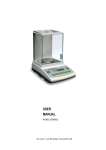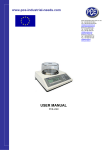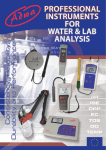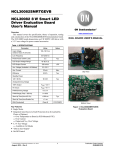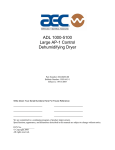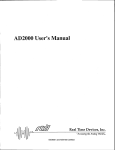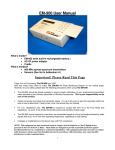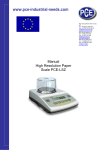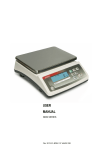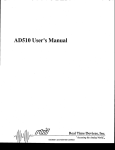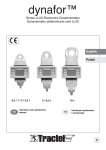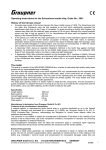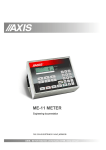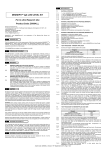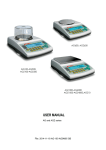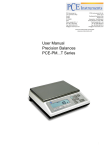Download User manual for AD series balances
Transcript
AD50-AD300 AD510-AD3000, AD2.5, AD5 AD6 USER MANUAL AD series File: 2013-06-04 AD-041 AC-5_11 GB 2 USER MANUAL _________________________________________________________________________________________________________________ Contents: 2. Technical data .................................................................................................................................................................... 4 3. Completeness .................................................................................................................................................................... 5 4. General view ....................................................................................................................................................................... 5 5. Keys and indicators ........................................................................................................................................................... 7 6. Security rules ..................................................................................................................................................................... 8 7. Preparations – working environment ............................................................................................................................... 9 8. Preparing a balance to work ........................................................................................................................................... 10 9. Operation principles ........................................................................................................................................................ 11 10. Start-up ............................................................................................................................................................................. 12 11. Basic functions ................................................................................................................................................................ 13 11.1 Normal weighing ............................................................................................................................................................. 13 11.2 Weighing with tare ........................................................................................................................................................... 13 12. Balance checking ............................................................................................................................................................. 14 13. Connecting a balance to a computer or a printer ......................................................................................................... 14 14. Special functions description ............................................................................................................................................ 16 14.1 Menu customization function (ACtIV) ............................................................................................................................. 17 14.2 Autozeroing (AUtOtAr) ...................................................................................................................................................... 18 14.3 Pieces counting (PCS) ...................................................................................................................................................... 19 14.4 Serial port working mode selection (SendInG) .............................................................................................................. 20 14.5 Serial port parameters setting (rS232) ........................................................................................................................... 21 14.6 Adjusting a balance (Calibr) ............................................................................................................................................. 22 14.7 Weighing unit selection (UnIt) .......................................................................................................................................... 24 14.8 Percentage weighing (PErCEnt) ...................................................................................................................................... 25 14.9 Weigh summation (rECIPE) .............................................................................................................................................. 26 14.10 Tare memorizing function (tArE) ................................................................................................................................... 27 14.11 Force measurement function (F) ................................................................................................................................... 28 14.12 Function for maximum value indication (UP) ............................................................................................................... 29 14.13 Anti-disturbance filter function (FILtEr) ....................................................................................................................... 30 14.14 Function for weighing animals (LOC) ........................................................................................................................... 31 14.15 Date and time setting (dAtE) .......................................................................................................................................... 32 14.16 Average calculation function (AVErAGE) .................................................................................................................... 33 14.17 Treshold comparing function (thr) ................................................................................................................................ 34 14.18 Total weight function (totAL) .......................................................................................................................................... 37 14.19 Density determination (hYdro) ....................................................................................................................................... 39 14.19.1 Solids density determination ........................................................................................................ 39 14.19.2 Liquid density determination ....................................................................................................... 41 14.19.3 Leaving the function .................................................................................................................... 42 15.20 Printout language selection (LAnGUAG) ...................................................................................................................... 43 14.21 Paperweight calculation (PAPEr) ................................................................................................................................... 44 14.22 Statistical calculations function (StAt) .......................................................................................................................... 45 15. Maintenance and repairs of small defects .................................................................................................................... 48 Declaration of Conformity ........................................................................................................................................................ 49 USER MANUAL 3 _________________________________________________________________________________________________________________ 1. Introduction AD series balances are destined for laboratory weighing where high accuracy is required. All balances are metrologically tested - calibration or legal verification certificate on demand. Legal verification is required for balances used in some applications: direct trade, pharmaceutical prescriptions, medical and pharmaceutical analysis, goods packing and others. Balances with legal verification are marked with the following: - protective seal placed on the casing mounting screw, - notified body stamps and green M sticker placed on balance name plate. Legal verification is valid for 3 years (until verification seals are not broken). As weight indication depends on gravitational acceleration in a place of the installation, the manufacturer adjusts balance indication for specific gravity zone basing on delivery address. Gravity zone is specified with gravitational acceleration range given on a sticker placed at the back of a balance. In case installation place is changed or balance indications are not accurate, it is advised to contact a nearest service in order to re-adjust the balance. NACE classification: 33.20.31. Certificates: EC Type-Approval Certificate No. PL 04 030 Producer Certificate EN ISO 9001:2000 No. 78 100 6386 USER MANUAL 4 _________________________________________________________________________________________________________________ 2. Technical data Type Capacity (Max) Min load (Min) Reading unit (d) Verification unit (e) Tare range Accuracy class Working temperature Weighing time Pan dimensions Balance base dim. Power Balance weight Calibration weight Type Capacity (Max) Min load (Min) Reading unit (d) Verification unit (e) Tare range Accuracy class Working temperature Weighing time Pan dimensions Balance base dim. Power Balance weight Calibration weight Type Capacity (Max) Min load (Min) Reading unit (d) Verification unit (e) Tare range Accuracy class Working temperature Weighing time Pan dimensions Balance base dim. Power Balance weight Calibration weight AD50 50g 0,02g 0,001g 0,01g -50g AD60 60g 0,02g 0,001g 0,01g -60g F2 50g F2 50g AD600 AD200 AD300 AD500 200g 300g 500g 600g 0,02g 0,02g 0,02g 0,04g 0,001g 0,001g 0,001g 0,002g 0,01g 0,01g 0,01g 0,02g -200g -300g -500g -600g II +18 ÷ +33 °C <8s 115mm 240x275x90mm ~230V 50Hz 6VA / =12V 500mA 4kg F2 100g F2 200g F2 200g F1 500g F2 500g AD510 500g 0,5g 0,01g 0,1g -500g AD100 100g 0,02g 0,001g 0,01g -100g AD1000 1000g 0,5g 0,01g 0,1g -1000g AD2000 2000g 0,5g 0,01g 0,1g -2000g AD3000 3000g 0,5g 0,01g 0,1g -3000g II +18 ÷ +33 °C <5s 150mm F2 500g 240x275x90mm ~230V 50Hz 6VA / =12V 500A 4kg F2 1000g F2 2000g F2 2000g AD5 AD5 legalised AD6 AD6 legalised 5000g 5g 0,1g 1g -5000g 5000g 25g 0,5g 0,5g -5000g 6000g 5g 0,1g 1g -6000g 6000g 25g 0,5g 0,5g -6000g II +18 ÷ +33 °C <5s 225x165mm 150mm 240x275x90mm ~230V 50Hz 6VA / =12V 500A 4kg 4,5kg F2 2000g USER MANUAL 5 _________________________________________________________________________________________________________________ 3. Completeness A standard set consist of: 1. Balance 2. Pan base and a pan 3. Feeder 230V 50Hz / =12V 1,2A 4. User manual 5. Guarantee Card 4. General view Balances AD50-AD600: 1 2 3 4 5 7 6 1 – pan 2 – pan support (under the pan) 3 – pan ring 4 – LCD display 5 – keys 6 – rotating legs 7 – water level Balances AD510, AD1000-AD3000 and AD2.5-AD5: 1 2 4 5 7 6 1 – pan 2 – pan support (under the pan) 3 – pan ring 4 – LCD display 5 – keys 6 – rotating legs 7 – water level USER MANUAL 6 _________________________________________________________________________________________________________________ Balances AD6: 1 2 4 5 7 6 1 – pan 2 – pan support (under the pan) 3 – pan ring 4 – LCD display 5 – keys 6 – rotating legs 7 – water level Rear view: Printer or computer Feeder RS232C RxD (receiver) TxD (transmitter) Adjust switch 1 2 3 4 gnd 5 chassis 6 7 8 9 ON OFF ~230V Feeder USER MANUAL _________________________________________________________________________________________________________________ 5. Keys and indicators T 0 MENU I/ - tare (subtract package weight from weighed mass), - zeroing (balances for direct sale use only) - data output (print / transmission), calibration/ navigation, mode switch, menu, switch-off (standby), result stabilisation, indicator - total load indicator (0-100%), bar indicator - stand-by mode, indicator OFF last digit overlined - inform that reading unit is less then verification unit (EC verificated balances de), Max, Min, d, e, II - metrologic parameters and accuracy class. Additional: - digit incrementation, - decimal point, T - next digit, MENU - end. 7 USER MANUAL 8 _________________________________________________________________________________________________________________ 6. Security rules To avoid electrical shock or damage of a balance or connected peripheral devices, it is necessary to follow the security rules below. All repairs and necessary regulations can be made by authorised personnel only. To avoid fire risk use a feeder of an appropriate type (supplied with a balance). Pay attention that supply voltage is compatible with specified technical data. Do not use a balance when its cover is opened. Do not use a balance in explosive conditions. Do not use a balance in high humidity. If a balance seems not to operate properly, plug it out of the mains and do not use it until checked by authorised service. According to legal regulations it if forbidden to dispose wasted electronic equipment in waste containers. Please return wasted scale to the point of purchase or other company specialised in recycling of wasted electronic components USER MANUAL 9 _________________________________________________________________________________________________________________ 7. Preparations – working environment +33°C +18°C When choosing a location to set up the balance, remember the following rules to ensure proper working conditions and user-friendly operating: - setup the balance on an even, flat surface leaving necessary room for easy access, - maintain proper working temperature, - avoid strong air drafts, vibrations, dust, big temperature changes and humidity over 90%, - avoid locations with extreme heat radiation and electromagnetic or magnetic fields. USER MANUAL 10 _________________________________________________________________________________________________________________ 8. Preparing a balance to work 1 2 3 7 6 1 2 7 6 1. Take all content out of a package. It is recommended to keep the original scale package in order to transport the balance safely in future. 2. Place the balance on a stable ground not affected by mechanical vibrations and airflows. 3. Level the balance with rotating rear legs 6 so that the air bubble in water-level at the back of the balance is in the middle. 4. (AD50-AD500) Put a pan base 2 on the mandrel sticking out of a balance cover 3. Put a pan 1 on a pan base (pan 150mm is connected to pan base). 5. (AD6) Put elements 2 on the mandrel sticking out of a balance, put a pan 1 . 6. Plug a feeder to the power socket at the back of the balance. USER MANUAL 11 _________________________________________________________________________________________________________________ 9. Operation principles 1. Weighed sample should be placed in the centre of the pan. 2. The balance is equipped with a tare equal to its range. To tare the balance press T key. Storing a tare value does not extend measuring range, but only subtracts it from a load placed on a pan. To make weight control easier and to avoid range overdrawing, the balance is equipped with a load indicator (graduated in percentages). 3. Weighing result should be read when the indicator " signalises stabilisation of a result. " lights, which 4. When the balance is not used but it is necessary to be ready to work immediately, it can be switched off by pressing I/ key. The balance reading system is then switched off to "standby" mode (signalled by the indicator "OFF"). To switch the balance on press I/ key. The balance is immediately ready to operate maximum accuracy (after self tests). 5. In direct sale use (d=e), make sure that zero indicator is displayed. If not, press 0 key and wait until zero indication and zero indicator appears. In other balances the key does not operate. 6. The mechanism of the balance is a precise device, sensitive to mechanical strokes and shocks. Before transportation take off the pan (move it slightly and lift it up) and the pan base and preserve from any damages. Do not overload the balance more than 20% of maximum load (Max). Do not press a pan with a hand. 7. The balance should not be used to weigh ferromagnetic materials due to accuracy decrease. USER MANUAL 12 _________________________________________________________________________________________________________________ 10. Start-up Moisture in the air may condense on the surface of the balance when transferred to the warmer environment. In this case leave the balance for at least 4 hours unplugged from the mains for conditioning to avoid wrong operating or damage of the balance. Leave the pan empty and plug the feeder to the mains 230V. At the end of selftests, the balance displays zero indication and is now ready to work Sequence of action after turn switch on: Display test Electronics components test Program version Zeroing. Ready to work. USER MANUAL 13 _________________________________________________________________________________________________________________ 11. Basic functions Following symbol graphic will be used in instruction: - loaded pan - unloaded pan 12g - press a key when ... (on left) T - forced change - automatic change - 11.1 Normal weighing 0.00 g T 43.04 g 11.2 When a pan is empty and indication is different than zero press T key. Weighing result should be read when the indicator " " lights. Weighing with tare 23.13 g 0.00 g 63.24 g T A balance is equipped with tare equal to its range. USER MANUAL 14 _________________________________________________________________________________________________________________ 12. Balance checking As weight indication depends on gravitational acceleration, it is advised to check balance indication accuracy before and after series of measurement using any load with known weight. To check a balance with legal verification use calibration weight as stated in Technical Data table with valid calibration certificate. In case permissible error is exceeded it is advised to contact the nearest service to calibrate a balance. 13. Connecting a balance to a computer or a printer The balance may send data to a computer or a printer via RS232C interface. RS232C 1 RxD (receiver) TxD (transmitter) 2 6 7 3 8 4 5 GND Case 9 When cooperating with a computer, the balance sends weighing result after initialising signal from a computer or after pressing key. When cooperating with the balance, a computer should be equipped with a program that enables receiving and processing data from the balance. AXIS offers computer programs to cooperate with balances. Demo versions and program descriptions are available on the website: www.axis.pl: - Komunikacja – free serial port testing program, - ProCell – residual program for cooperation with Microsoft EXCEL and other Microsoft Windows applications (demo version). USER MANUAL 15 _________________________________________________________________________________________________________________ Detailed information for programmers: The balance sends data with a following method: Computer Balance: initiation signal S I CR LF (53h 49h 0Dh 0Ah), Balance Computer: weighing result in the following format: (16Bytes, LONG protocol - 8bits, 1stop, no parity, 4800bps), Bytes description: 1 - „-„ mark or space 2 - space 34 - digit or space 5÷9 - digit, decimal point or space 10 - digit 11 - space 12 - k, l, c, p or space 13 - g, b, t, c or % 14 - space 15 - CR 16 - LF Connection cable WK-1 (balance – computer / 9-pin): BALANCE COMPUTER Connection cable WD-1 (balance - KAFKA printer): BALANCE PRINTER Setup of printer internal switch – printer AXIS C-001: SW-1 on SW-2 off SW-3 SW-4 SW-5 SW-6 SW-7 SW-8 on off off on off off 16 USER MANUAL __________________________________________________________________________________________________________________ 14. Special functions description List of available functions: menu customization function (ACtIV), removal of all function from menu (dEFAUL). autozeroing function (AutoTar), pieces counting function (PCS), function for setting serial port working (SEndIng), function for setting serial port parameters (RS232), extended calibration function (CALIbr), changing measurement unit (UnIt), percentage weighing function (PErCEnt), recipe weighing function (rECIPE), entering tare function (tArE), force measurement (F), maximum value indication function (UP), anti-disturbance filter function (FILtEr), weighing large animals function (LOC), average calculating function (AVErAGE), determining solids and liquids density function (hYdro)* statistical calculations (StAt)- option* paperweight calculation function (PAPEr)* function with additional equipment require: options with the clock: - setting current date and time function (dAtE) - total weight function (totAL) options with the transoptors connectors: - checkweighing function (thr) *depending on scale memory space limitation this function replaces other special function Other special functions may be enabled as an option on customer request (described in additional brochure when ordered). Function menu is displayed after pressing MENU button. For easy access to the most frequently used functions, use ACtIV function for selecting functions that will be displayed in functions menu. When special function is active, MODE indicator is displayed. USER MANUAL 17 ___________________________________________________________________________________________________________________ 14.1 Menu customization function (ACtIV) 0.00 ACtIV o T Operation sequence shown in the pictures on the left causes adding function of setting serial interface RS232C parameters (rS232) to function menu. PCS rS232 T rS oFF rS on Among available user functions it is possible to select these, which should be displayed after pressing MENU key. It allows avoiding displaying whole list of available functions, which makes operation time longer. After switching on ACTIV function a dot is displayed on the right side (to distinguish from regular menu). Chosen functions are displayed with a dot on the left side. In every moment, it is possible to restore primary (manufacture) settings choosing dEFAULt special function. T In order to delete this function from menu in last operation choose rS oFF instead of rS on. USER MANUAL 18 __________________________________________________________________________________________________________________ 14.2 Autozeroing (AUtOtAr) 0.01g AUtOtAr MENU T AUt oFF AUt on AUT 0.00g When AUtotAr function is activated, a balance automatically keeps zero indication if a pan is empty or if zero indication was acquired by pressing T key. To leave the function press MENU key, then with T key chose AUtOtAr and AUt oFF . Note: Autozeroing function is activated automatically for 10 min. after switching-on T USER MANUAL 19 ___________________________________________________________________________________________________________________ 14.3 Pieces counting (PCS) 12.05 g T 0.00 g 5 23.04 g PCS MENU T PCS oFF PCS on T PCS PCS 5 0 pcs 12 12 pcs T This function enables to count identical pieces, e.g. turnbuckles or buttons. A measurement is performed in two phases: - first phase - single piece weight calculation on the basis of defined pieces amount (5, 10, 20, 50, 100, 200 or 500 pieces), - second phase – pieces counting. It is advised that single piece weight is not less than one reading unit and sample weight used in first phase is bigger than 100 reading units. To leave function press F key and then with T, key chose PCS and PCS oFF . Note: Err-3 communicate signalises that a sample was not put on a pan. The same communicate appears if single piece weight is less than one reading unit (it is possible to count pieces but measuring error is bigger). To chose previously used pieces amount select “..” in first phase. During pieces counting T key function does not change USER MANUAL 20 __________________________________________________________________________________________________________________ 14.4 Serial port working mode selection (SendInG) 0.00g MENU - SEndInG T - Stb Auto 0.00g - T The function enables to set the serial port working mode. StAb – transmission after using key and indication stabilization, no – StAb – transmission after using key without stabilization, Auto – after putting and taking off the weighed object without using , Cont. – about 10 results per second. Auto mode is suggested when working with printer. USER MANUAL 21 ___________________________________________________________________________________________________________________ 14.5 Serial port parameters setting (rS232) 0.00g MENU rS232 T baud T -4800 -9600 T bIt T PArItY T Odd T out T The function enables to set the following transmission parameters (standard parameters underlined: - transmission speed (bAud: 1200, 4800, 9600, ...), - the number of bits in a byte (bit: 7, 8), - parity control (PArItY: 0, 1; Odd: 0, 1), To set desired transmission parameters activate RS232 function, choose appropriate parameter and press T key to accept needed parameter value. The example at the left presents how to set transmission speed value to 9600bps. To leave the function choose out option USER MANUAL 22 __________________________________________________________________________________________________________________ 14.6 Adjusting a balance (Calibr) If balance indications exceed permissible error it is necessary to adjust the balance. To calibrate the balance use calibration weight as stated in Technical Data table (or of better accuracy) with valid calibration certificate. To adjust a balance it is necessary to break protective marks – please contact the nearest service for legal verification in a place of installation or the nearest Measurements Office. Przełącznik Adjuster adjustacji OFF ON Adjuster securing Cecha zabezpieczająca element dostęp do przełącznika adjustacji In legalized scales to perform calibration it is needed to change adjuster position. Adjuster is situated under adjuster securing element. Calibration report (CAL Prn): Data: CALIBRATION REPORT --------------------------------------------------------------------------FACTORY NUMBER: ... PROGRAM NUMBER: (version, date) USER MANUAL 23 ___________________________________________________________________________________________________________________ Operation sequence: 0.00g CALIbr CAL on MENU OFF ON T T Switch to Pr ON position using small screwdriver (signalised on a display). Press MENU to call special functions. Press T to choose CALIbr and CAL on. m1 m2 ... m Remove a protective mark from a calibration switch at the back of a balance. T Press several times to select desired weight value. It is advised to use as great weight value as possible. Press T to accept. m LOAD C When LOAD appears put the weight on a pan. Wait. unLOAD When unLOAD appears take off the weight. 0.00g Switch to Pr OFF position using small screwdriver ( Pr ON disappears). USER MANUAL 24 __________________________________________________________________________________________________________________ 14.7 Weighing unit selection (UnIt) 1.60g MENU Use this function weighing unit: to choose UnIt T - carats (1 ct= 0,2 g), - pounds (1 lb=0,454kg), - grams. CArAt T The example presents how to set carats as weighing unit. 8.00 ct USER MANUAL 25 ___________________________________________________________________________________________________________________ 14.8 Percentage weighing (PErCEnt) 0.00 g 100% 19.07 g MENU PErCEnt T PEr oFF PEr on 100.00% 50% 50.00% T This function enables to display weighing result as a percentage of a reference sample. A measurement is performed in two phases: - first phase – weighing a reference sample, - second phase – measuring specific sample as a percentage of the reference sample. Weighing result is displayed in different format, depending on the reference sample weight value. For values of 0÷3,5% of weighing range the format is “100.0”, for values 3,5÷35% it is “100.00” and 35÷100% - “100.00” The function has the following options: - PEr oFF – disables the function, - PEr on – stores current indication as 100% and activates percentage weighing, Note: Err-3 communicate signalises that a sample was not put on a pan. The same communicate appears if 100% piece weight is less than 0,5*Min of scale When the function is activated ->T<- key function does not change. USER MANUAL 26 __________________________________________________________________________________________________________________ 14.9 Weigh summation (rECIPE) 0.00 g rECIPE MENU T rEC oFF rEC on T o 10.01g T A B o 0.00g o 10.02g C o 0.00g o 10.03g SUM 30.06g T This function enable to weigh few ingredients in one container and to display aggregated sum of all ingredients. The function has the following options: -rEC oFF – leave the function and display aggregated sum of all ingredients, -rEC on – activate the function, -rEC Con - return to previous series of weighing. Before weighing each ingredient (A, B, C, etc.) remember to tare the balance. To read aggregated sum of all previously weighed components press key or use rEC oFF option. To return to ingredients weighing press key again. Note: When rECIPE function is active, the sign o is displayed at the left of the display. When rEC oFF option was used, SUM indicator disappears after pressing T key. USER MANUAL 27 ___________________________________________________________________________________________________________________ 14.10 Tare memorizing function (tArE) This function enables to measure gross weight of a sample placed in a container of a known weigh value (stored in the memory) and to display calculated net weight of the sample. Tare value is recalled from the memory with T (or 0 when pan is unloaded). Tare value may be entered using the keypad or by sampling container weight from the pan. Inserting tare value using keypad: 0.00g tArE T VALUE T 2 T 220 -20.00g 0.00g 50.00g MENU After pressing MENU key and choosing tArE function using T key ,functions below are displayed: - tAr OFF – function off, - tAr on – function on with tare inscribed earlier, - PAn – actual mass on pan setting as tare, - VALUE – inscribing tare using: , , T i MENU. Choose tare inscribing function using T key. After inscribing scale works with new tare value. The scale will show nett mass (the actual object mass minus tare value). Each using of T key (or 0, when the pan is unloaded) will cause zeroing, and deleting memorized tare value (user will see minus indication) . ATTENTION: Tare value is also memorized after the scale is turned off. USER MANUAL 28 __________________________________________________________________________________________________________________ 14.11 Force measurement function (F) 0.00 g F F MENU T on 0.000 T Function activation causes displaying measurement results in force units (mN). Press MENU key . Using T key choose F function, and then F on. Attention: 1mN0,1019g USER MANUAL 29 ___________________________________________________________________________________________________________________ 14.12 Function for maximum value indication (UP) This function allows holding on display maximum value shown by the scale in a while Before measurement the scale should be tared. 0.00 g MENU After using MENU key, choosing UP function , and then UP_on, the highest mass result will be hold on display. UP T Pressing T key will cause result zeroing. UP oFF UP on MAX 0.00g MAX 9.90g MAX 9.90g T ATTENTION: Autozeroing function and the stabilisation indicator are deactivated when UP function is running. Weighing result is continuously averaged from 5 measurements. USER MANUAL 30 __________________________________________________________________________________________________________________ 14.13 Anti-disturbance filter function (FILtEr) 0g FILtEr T This function allows using digital filter with selected intensivity during weighing. Filter reduces the influence of mechanical vibrations (air blasts, base vibrations) on measurement result. T Press MENU key and select FILtEr by pressing T key. The following options will be shown successively on display: - FIL OFF – filter off - FIL-1 - filter I (weak) - FIL-2 - filter II (medium) - FIL-3 - filter III (sharp) - FIL-4 - filter IV (very sharp) Select on of four filters. This will cause starting weighing with selected filter. MENU FIL oFF FIL- 1 FIL- 2 FIL- 4 Filter 0g In order to go back to normal weighing use MENU key once more and choose FILtEr and FIL-0. USER MANUAL 31 ___________________________________________________________________________________________________________________ 14.14 Function for weighing animals (LOC) The function allows weighing animal moving on the scale. 0.00g MENU LOC T LOC oFF LOC on 25.00g PrInt 25.00g T Press MENU key. When LOC is displayed press T key. The following options appear on display successively: - LOC oFF – out of function, - LOC on –automatic measurement after loading the scale, - LOC Prn – measurement initiated by pressing key. When LOC on is displayed press T key. Tare the scale using T key if necessary and place the animal on the pan. Wait until the weighing result is averaged – scale display will be blinking. Then scale will show stable averaged result and will send it through serial port. Final result is displayed on the display and send via serial port to computer or printer. The result remains on display for about 30 second. Important notes: 1. The loads less than Min are not averaged. 2. In the case when placing the animal takes more than 5s, it is advised to use LOC-2 option (measurement initiated manually). It will allow performing measurement in right moment pressing key. USER MANUAL 32 __________________________________________________________________________________________________________________ 14.15 Date and time setting (dAtE) 0.00g dAtE MENU T dAt oFF dAt SEt T h13 - 18 T Options: - dAt oFF – deactivate date printout, - dAt on – activate date printout (using key), -dAt SEt – change date and time. The example at the left presents how to set current date and time. Time format: h gg – mm (g - hour, m - minute) h13 - 18 h13 - 19 This function enables to set current date and time of internal balance clock and enable/disable date and time on weighing result printouts. T h13 - 19 Date format: d mm – dd (m - month, d - day). d04 - 05 Year format: r - rr (r - two last digits of a year). r - 06 - 0.00g USER MANUAL 33 ___________________________________________________________________________________________________________________ 14.16 Average calculation function (AVErAGE) The function allows for calculating average value of performed measurement series. During series of measurements successive results are registered automatically when scale indication is stabilised. 0.00 g MENU AUErAGE T AUE on T 0.00 g 1.00 g 0.00 g 2.00 g 0.00 g 2 n _ _ 1.50 g 0.00 g Press MENU key and select AUErAG pressing T key. The following will be shown successively on display: - AUE oFF – leaving function, - AUE on – measurement with average calculation. - out Select AUE on usingT key. It will allow weighing with simultaneous storing results into summing register for average calculation. Measurement registration is performed automatically in the moment when scale indication becomes stable. Short time displaying of „ - - ” denotes that load can be taken off and new one can be put on. Results above scale Min are only registered. Number of measurements is limited to 9999. In order to read average value key should be used. - first pressing causes displaying number of measurements (n). - second pressing causes displaying average value (=). - third pressing allows continuing average calculation. If a printer is connected to scale the following report will be printed : Date: ... Time. ... MEASUREMENS No AVERAGE VALUE = ... = ... In order to finish calculation press MENU key, and then select AUErAGE i AUE oFF. USER MANUAL 34 __________________________________________________________________________________________________________________ 14.17 Treshold comparing function (thr) This function allows comparing weighing result with two programmed reference values: lower and upper threshold. Comparison result is signalled with indicators (MIN, OK, MAX) and sound signal generated when threshold values are exceeded. Operation sequence: Press MENU key and choose thr 0.00g MENU pressing T key. The following options are displayed successively: - trESh oFF – deactivate the function, thr T - trESh on – activate the function, - trESh Prn – check last threshold values (press key several times), thr oFF - thr CFG – function configuration (working mode, buzzer, flashing setting). thr on T Choose thr on option using T key. The following options for entering thresholds are displayed: SEt-1 - SEt-0 - go to weighing with T signalling threshold excess, - SEt-1 - set lower threshold value, - SEt-2 - set upper threshold value, - SEt-3 - set zero signalisation threshold. Using T key select SEt-1 option. 5 T Set lower threshold value using the following keys: - digit increase, 5- decimal point, T - move to next digit, 50 MENU MENU - finish. Then select SEt-2 option and enter upper threshold value. SEt-2 SEt-0 OK 62.00g T T Choosing Set-3 option will cause starting work with signalisation of exceeding thresholds and zero. To leave the function, press MENU key and then choose thr and thr-0 options. USER MANUAL 35 ___________________________________________________________________________________________________________________ If the comparison result is : - smaller than lower threshold – the scale signals MIN (yellow colour), - between threshold values - the scale signals OK (green colour, with the short sound signal), - greater than upper threshold - the scale signals MAX (red colour, long sound signal). The checkweighing results can be use to control: - optical indicator (Indication mode), - batching devices (Batching mode). If we choose thr CFG option following options will appear: - thr Out (working mode setting), - thr buZ (buzzer work settings: EHC – buzzer turns on after exceeding threshold; STB – signal on after result stabilization in OK section), - thr FLA (flashing on when lower or upper threshold is exceeded) - out User can choose from 3 working modes for thr out. After choosing thr Out option following options display: - Out off, - Out IPL (batching mode), - Out bSt ( level mode), - Out SGn (indication mode). Standard scale is set for cooperation with optical indicator. On the chart below output states are shown during increasing load on the scale for both working modes: Indication mode: P1 Batching mode: P1 zero treshold thr I thr I P2 P2 thr I thr II P3 thr II P3 thr II zero treshold USER MANUAL 36 __________________________________________________________________________________________________________________ Level mode: Outputs: P1 zero treshold Min threshold P2 Min threshold Max threshold P3 Max treshold In Batching mode on P1 (thr I) and P2 (thr II) outputs short-circuit impulses appears for time of 0,5s. On P3 (zero) output short-circuit state appears when indication does not exceed threshold value signalling zero load. Relays connection diagram: Scale Relay Imax < 25mA Relays output is the open collector transoptor output with load capacity 25mA / 24V. Transmitter inputs must be protected with diodes, e.g. 1N4148. It is advised to use MS3K/P electronic board (sold separately), consisting of RM96P transmitters, with DC24V input voltage and AC250V, 3A output. Important notes: 1. After switching the scale on, both thresholds are set to maximum values. 2. When setting upper threshold value, pay attention that its value is not below lower threshold value. 3. Setting lower and upper threshold value is possible after sending appropriate orders from computer, what is described in scale user manual. . . USER MANUAL 37 ___________________________________________________________________________________________________________________ 14.18 Total weight function (totAL) The function allows calculating total weight for series of measurements, which can be greater than scale capacity. It allows calculating total weight as well as average value. 0.00 g Press MENU key. When totAL is displayed press T MENU key. totAL T tot T 150.01g 0.00g The following options appear successively: - tot Prn - report printout without clearing total register, - tot oFF - clearing total register, report printout and leaving the function, - tot □ - working with receipt printout after each measurement, - tot - working without receipt printout. Press T key when tot □ is displayed. Perform measurement series pressing key for storing results into total register. 120.00g 0.00 g TOTAL 20 n 0.00g In order to display results press key . Also it can be done by using totAL function and choosing option tot Prn. The results are display in the following sequence: - total weight () - number of registered measurements (n), - average value (=), Pressing again key enablespozwala kontynuować sumowanie ważeń bez zmiany zawartości rejestów. In order to go back to total weighing without zeroing total register press key third time. 38 USER MANUAL __________________________________________________________________________________________________________________ To leave the function with clearing total register, select total function from menu and choose tot-0 option. When It will cause the scale prints the communicate informing about clearing registers. The form of receipt after each measurement: Date: ... Time. ... measurement no weight measurement no weight Report form: Date: ... Time. ... TOTAL WEIGHT = NUMBER OF SAMPLES = AVERAGE VALUE = Note: When the scale has not an internal clock, Date and Time do not appear on printout. Maximum number of measurements 99 999. Maximum total load 99 999 000d. The weighing unit of the total value from the register (Total) is the same as the weighing unit stated on the keypad or is 1000 times greater, what is signalled by “o” indicator at the left of the display. If the registered value is too big to be displayed, “E” communicate appears on the display. If the number of series is too high and cannot be displayed, “Err1”communicate appears on the display. USER MANUAL 39 ___________________________________________________________________________________________________________________ 14.19 Density determination (hYdro) The description below describes density determination using HYDRO kit. In case below-balance weighing, operation sequence does not change. 14.19.1 Solids density determination 0.000g MENU hYdro T This function calculates material density basing on its weight in air and in water using the formula below: m mm * L 1 1 hyd on T SOLId T H2O T t C 18 LOAD_H 10.000g 2 where, m1 – weigh in air m2 – weight in water L - density of liquid If distilled water is used, enter its exact temperature (accurate to 0,5°C) – the balance will calculate its density automatically. T MENU To enter the value use the following keys: - digit increase, - decimal point, T - next digit, MENU - end. When using liquid other than distilled water, choose OTHER (instead of H2O) option and enter its density according to its temperature. Phase I: measurement in air. LOAD_L 9.000g -- Phase II: measurement in liquid. To print measurement result and begin next measurement press key. USER MANUAL 40 __________________________________________________________________________________________________________________ To print a density determination report after all necessary measurements, connect a printer to the balance and press P key. A sample for solid mass density determination is shown below: Date: ... MEASUREMENT NO. WEIGHT in air WEIGHT in a liquid DENSITY Time ... = ... = ... g = ... g = ... g/cm3 Liquid density Liquid temperature = ... g/cm3 = ... oC Operation sequence (weighing in air and in liquid) for below-balance weighing: Phase I: measurement in air. Phase II: measurement in liquid. USER MANUAL 41 ___________________________________________________________________________________________________________________ 14.19.2 Liquid density determination 0.000g hYdro MENU T hYd on T LIquId T PLunG 5.51 LOAD_H 22.001g This function determines liquid density basing on plunger weight in air and in examined liquid with known volume, using the formula below: m1 m2 V where m1 – plunger weight in air m2 – plunger weigh in a liquid V – plunger volume T MENU Plunger volume is stored on its hanger. To enter the value use the following keys: - digit increase, - decimal point, T - next digit, MENU - end. Phase I: measurement in air. LOAD_L 11.500g -- Phase II: measurement in liquid. To print measurement result and begin next measurement press key. USER MANUAL 42 __________________________________________________________________________________________________________________ To print a density determination report after all necessary measurements, connect a printer to the balance and press key. A sample for liquid density determination is shown below: Date: ... MEASUREMENT NO. WEIGHT in air WEIGHT in a liquid LIQUID DENSITY PLUNGER VOLUME Time ... = ... = ... g = ... g = ... g/cm3 = ... g/cm3 14.19.3 Leaving the function -- 6.6635 To stop using the function, follow operation sequence as shown on the picture. LOAD_H 0.000g -0.000g MENU In other case the balance begins next density measurement. USER MANUAL 43 ___________________________________________________________________________________________________________________ 15.20 Printout language selection (LAnGUAG) LAnGUAG function enables to select printouts language (calibration reports, total printouts and hYdro). Press MENU key. When LAnGUAG function appears press T key. On the screen will succesively appear: - POLISh , - ENGLISh, - GErMAn, - rUSSIAn, - UkrAIn , - CZECH, - SPAnISH, - out. Choose the proper language and press T while it’s displaying. Example of printouts in polish and English language: - calibration report RAPORT Z KALIBRACJI NUMER FABRYCZNY NUMER PROGRAMU MASA KALIBRACYJNA PIERWOTNA MASA KALIBRACYJNA RÓŻNICA MAS CALIBRATION REPORT FACTORY NUMBER PROGRAM NUMBER CALIBRATION PRIMARY MASS CALIBRATION MASS DIFFERENCE MASS - total function report UWAGA ! WYZEROWANIE REJESTRÓW stan przed wyzerowaniem TOTAL WARTOŚĆ ŚREDNIA LICZBA NAWAŻEK PRZEKROCZENIE ZAKRESU WARNING! ZEROING REGISTER results before zeroing TOTAL AVERAGE VALUE NUMBER OF MEAS RANGE EXCESS USER MANUAL 44 __________________________________________________________________________________________________________________ 14.21 Paperweight calculation (PAPEr) This function enables to calculate paperweight of 1m2 of paper basing on samples of known area. For quick access, the function is accessible directly by pressing key. The balance must be tared just before the measurement. Place the specific sample quantity 0.000 g T of the same area (possible values: 1, 2, 5, 10, 20, 50, 100). Press MENU key to access Function 5 Menu. To enter the function press 1.338 g MENU T key when “PAPEr” is displayed. PCS is the number of samples placed on the pan. To choose PAPEr T previously used value, select old option. PCS T n=5 T ArEA T P=0.02 T 13.3 = g/m 2 "ArEA" is the area of a single sample. It is possible to choose standard values (0,02 or 0,1g/m2) or enter specific value (“A” option). To enter the value use the following keys: - digit increase, - decimal point, T - next digit, MENU - end. The result of paperweight measurement is finished with “=” mark pointing g/m2 unit. The balance is ready for the next measurements. key causes passage to mass measurement and enables next samples (with other quantity and surface of a single sample) measurement start. USER MANUAL 45 ___________________________________________________________________________________________________________________ 14.22 Statistical calculations function (StAt) Attention: Function is available on demand and it replaces other special functions. This function evaluates from series of measurements (max 500) statistical parameters of weighting process. Adding successively measurements to register is automatic and it occur after the scale is loaded and its indications stabilize. After each loading printout is made with: number of measurements, result, date and time. Next measurement is made after taking off earlier load. For the obtained measurements series the scale evaluates: -n - number of samples - sum x - sum of all samples sum _ x xn - x -average value (sum x)/n - min -minimal value from n samples - max -maximal value from n samples - max-min -maximal value minus minima value -S -standard deviation - srel -variance factor 1 ( xn x ) 2 (n 1) n S srel Statistical calculations results can be printed. S x USER MANUAL 46 __________________________________________________________________________________________________________________ 0.00 g MENU StAt T StA o T 0.00 g 1.00 g 0.00 g 2.00 g 0.00 g MENU StAt T StA Prn T 2 n _ _ 1.50 g 1. Press MENU key. 2. When StAt is displayed press T key. Following options will show successively on display: - StA Prn – monitoring and printout of statistical data, - StA oFF – function off, - StA o – function on, working with single weight results printout, - StA - – function on, working without single weight results printout, - StA CFG – function configuration: -Auto – automatic work (sample is confirmed after putting load and indication stabilization), -ManuAL – manual work (confirmed by pressing key). - out – out of function. 3. Press T key when StA o is displayed . 4. Put successively samples of product on the pan, (take off after indication stabilization) in order to inscribe them into measurement register. 5. In order to obtain statistical results for measurement series press MENU key and T key when the StAt. sign is displayed and then StA Prn. Successive results are displayed after pressing key: n – sample number. - average mass, - standard devation, % - relative standard devation, MIN – minimal mass, MAX – maximal mass, 0.00 g After pressing T key during StA End displayed, user can end displaying statistics. USER MANUAL 47 ___________________________________________________________________________________________________________________ This will cause printout of calculated statistics and histogram : LSL allowable lower value, USL - allowable upper value, A, B, C, .. – measurement intervals, nA ... – amount of measurements in A interval; measurement is in A interval if it is bigger or equal to A interval threshold and smaller than B interval threshold. nB ... - amount of measurements in B interval; measurement is in B interval if it is bigger or equal to B interval threshold and smaller than C interval threshold. Thresholds are printed under histogram. -NG - amount of measurements under allowable lower value +NG - amount of measurements above allowable upper value To finish work with this function and zeroing result register press F key, then during "StAt" and "F." is displayed, press T key. This will cause printing message about register zeroing. Data: ... SAMPLES TOTAL MASS AVER MASS MIN MASS MAX MASS = MAX – MIN S SREL Hour. ... = ... = ... = ... = ... ... = ... = ... = ... *HISTOGRAM* LSL ... USL ... DIV ... -NG LSL A B C D E F G H I J USL +NG A B C D E F G H I J ... nA nB nC nD nE nF nG nH nI nJ ... ~ ~ ~ ~ ~ ~ ~ ~ ~ ~ ... ... ... ... ... ... ... ... ... ... ... Measurement made by : ____________ USER MANUAL 48 __________________________________________________________________________________________________________________ 15. Maintenance and repairs of small defects 1. A balance should be kept clean. 2. Take care that no dirt gets between a casing and a pan. If found any, remove a pan (lift it up), remove dirt and then replace a pan. 3. In case of improper operation caused by short-lasting power supply decay, unplug a balance from the mains and then plug it again after few seconds. 4. To calibrate a balance contact your nearest service (it is necessary to make legal verification again) 5. It is forbidden to make any repairs by unauthorised persons. 6. To repair a balance, please contact our nearest service. Balances can be sent for repair as messenger delivery only in original package, if not, there is a risk of damaging the balance and loosing guarantee. Error communicates: Communicate Possible cause C-1 ... 6 (over 1 min.) L H Recommendation selftests failed if displayed more than 1 minute, contact an authorised service pan missing put the pan on mechanical damage contact an authorised service overloading the scale was switched on with loaded pan mechanical damage of the load cell unstable weighing indications remove the load from the pan remove a load from the pan indicator does unstable ground vibrations air flows contact an authorised service press F key, contact an authorised service place the scale on a stable ground not affected by mechanical vibrations and airflows not appear scale is damaged contact an authorised service taring in progress as above Calibration switch is in ON position or switch is damaged Change switch position into OFF or contact authorised service -----Pr-on USER MANUAL 49 ___________________________________________________________________________________________________________________ Declaration of Conformity We: AXIS Spółka z o.o. 80-125 Gdańsk, ul. Kartuska 375B confirm with all responsibility that scales: AD50, AD60, AD100, AD200, AD300, AD500, AD600, AD250, AD510, AD1000, AD2000, AD3000, AD2.5, AD5, AD6 marked with CE mark comply with the following: 1. EN 55022:2000 Electromagnetic compatibility (EMC) – information technology equipment – Radio disturbance characteristics - standard Limits and methods of measurement and IEC 61000-4-3 Electromagnetic compatibility (EMC) - Part 4-3: Testing and measurement techniques Radiated, radio-frequency, electromagnetic field immunity test harmonized with the directive 2004/108/WE (Electromagnetic compatibility). Moreover scales with the following markings on the name plate: xx - the number of the Notified Body responsible for EC verification, - two-digit number of the year of EC verification, - a green metrology sticker with “M” mark, - a protective seal affixed by the Notified Body. comply with the requirements on the Type-Approval Certificate No. PL 04 030 and are verified to comply with: 2. EN 45501 norm Metrological aspects of non-automatic weighing instruments and with 2009/23/WE directive. Additional information - Conformity evaluation for the Council Directive 73/23/EEC and 89/336/EEC (replaced by 2006/95/WE and 2004/108/WE) was carried out by Laboratorium Badawcze Oddziału Instytutu Elektrotechniki in Gdańsk, accredited by PCA - Type-Approval Certificate No. PL 04 030 was issued by Główny Urząd Miar in Warsaw (Notified Body no. 1440). Per pro Director of AXIS Sp. z o.o.: Production Manager Jan Kończak ________________ Date: 25-04-2012 50 USER MANUAL __________________________________________________________________________________________________________________ Notes




















































